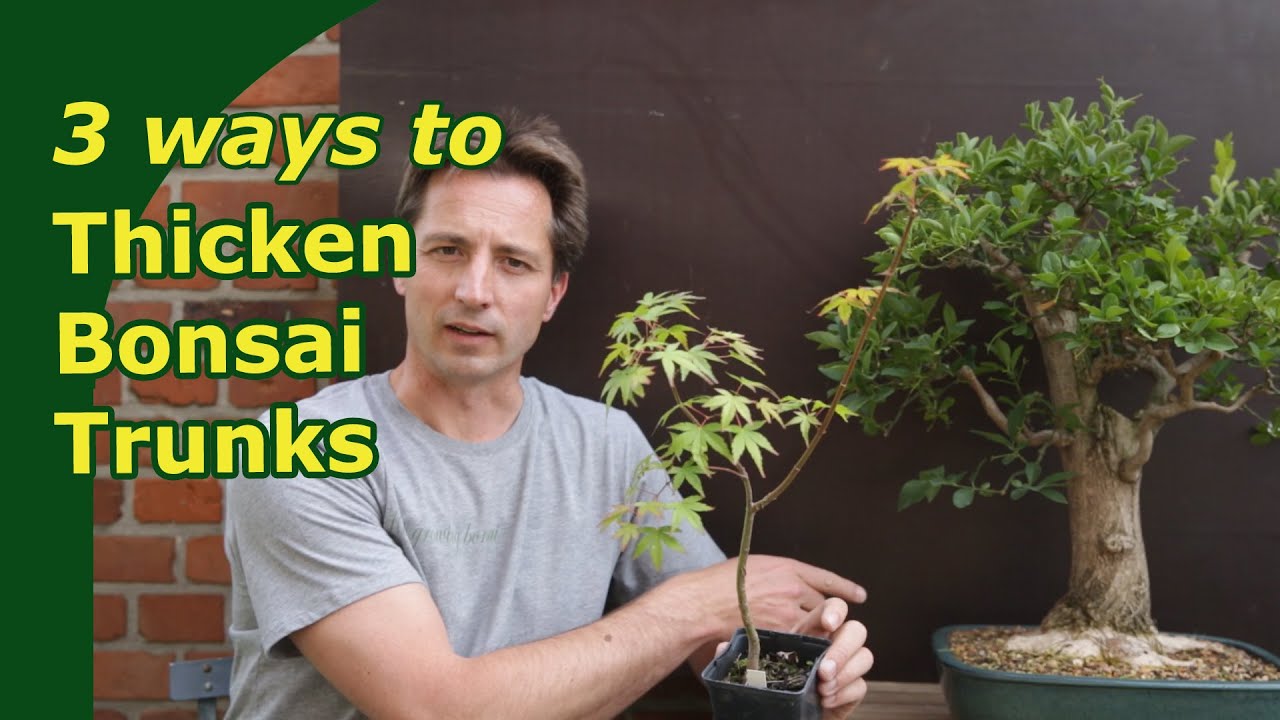To thicken a bonsai trunk, you can prune regularly, apply appropriate fertilizers, and wire and shape the trunk during its development stage. A bonsai trunk is one of the most important features of a bonsai tree, as it adds to the aesthetic appeal and overall balance of the tree.
A thick and sturdy trunk gives the impression of age and maturity. While achieving a thick trunk may take time and patience, there are several steps you can take to encourage its growth. Regular pruning helps redirect energy to the trunk and promotes thickening.
Applying suitable fertilizers, rich in nutrients, can also aid in trunk development. Additionally, carefully wiring and shaping the trunk during the tree’s growth stage can encourage it to thicken. Following these methods will result in a well-proportioned and visually appealing bonsai tree.

Credit: www.reddit.com
Why Thicken Bonsai Trunks
One crucial aspect of bonsai aesthetics is the thickness of the trunk. The thickeness of the trunk helps in creating a balanced and more mature appearance for the bonsai tree. A thicker trunk adds visual appeal and stability to the overall bonsai design.
It gives the tree a sense of age, strength, and character. The trunk is considered the backbone of a bonsai tree, and a well-developed trunk can make or break the overall look of the bonsai. To thicken the trunk, you need to focus on proper pruning, wiring, and creating a favorable environment that encourages growth.
These techniques will help your bonsai tree develop a stronger trunk over time, enhancing its beauty and making it a true work of art.
Understanding The Bonsai Trunk
The thickness of a bonsai trunk is a crucial aspect of its overall appearance and aesthetic. Understanding the anatomy of a bonsai trunk is essential in achieving the desired thickness. The trunk consists of several layers, including the bark, cambium, and wood.
Factors such as genetics, age, and environmental conditions play a significant role in determining trunk thickness. Genetics dictate the inherent potential for trunk thickness, while age allows for the gradual development of the trunk over time. Environmental conditions such as sunlight, water, and nutrients influence the growth and expansion of the trunk.
To effectively thicken the bonsai trunk, it is important to choose species with the potential for thickening and provide optimal growing conditions. Regular pruning, proper wiring techniques, and adequate fertilization can also contribute to the desired trunk thickness. By understanding the various factors and implementing the appropriate techniques, bonsai enthusiasts can successfully achieve the desired thickness of the trunk in their miniature trees.
Strategies For Thickening Bonsai Trunks
Strategies for thickening bonsai trunks revolve around appropriate pot selection and correct watering techniques. Choosing a pot that allows the roots to spread and has sufficient depth promotes trunk development. Avoiding pots that restrict root growth is crucial. Additionally, watering plays a vital role in trunk thickening.
Ensuring the bonsai receives adequate water without overwatering is key. Water deeply, allowing the soil to dry out slightly between waterings. This encourages the roots to search for moisture, resulting in a thicker trunk. Furthermore, using a well-draining soil mix aids in maintaining moisture balance while preventing waterlogged roots.
It’s important to be patient and consistent with these strategies for the best results. So, follow these guidelines for a healthier and stronger bonsai trunk.
How to Thicken Bonsai Trunk: Step by Step Guide
Promoting Trunk Trunking Through Pruning
Promoting trunk growth in bonsai trees involves understanding the principles of pruning. By carefully cutting away excess branches and foliage, you can encourage the development of a thicker trunk. It’s important to prune at the right time and in the right way to achieve optimal results.
Techniques such as directional pruning and selective removal of branches can help redirect growth and stimulate trunk thickening. A balanced approach is key, ensuring that the bonsai receives enough sunlight, water, and nutrients to support healthy growth while promoting trunk development.
Regular monitoring and adjustment of pruning techniques are necessary to maintain a strong and aesthetically pleasing bonsai trunk. With patience and proper care, you can witness the transformation of a slender trunk into a beautifully thickened centerpiece in your bonsai collection.
Utilizing Training Techniques
To thicken the trunk of a bonsai tree, one effective training technique is wiring. By carefully wrapping wire around the trunk, you can guide its growth and encourage it to become thicker. This method helps create definition and structure within the bonsai’s design.
Another technique that can be employed is the use of guy wires. These wires provide additional support to the trunk, allowing it to develop in a desired direction. They are particularly useful when training young or weak trunks that may not be able to support their own weight.
By utilizing these training techniques, bonsai enthusiasts can enhance the overall appearance and strength of their trees, resulting in stunning and impressive displays.
Importance Of Proper Nutrition
Proper nutrition plays a crucial role in thickening the trunk of a bonsai tree. Choosing the right fertilizers is essential for providing the necessary nutrients for trunk development. The right balance of nutrients promotes healthy growth and increases the diameter of the trunk.
It is important to select fertilizers that contain a blend of nitrogen, phosphorus, and potassium, as well as trace elements like iron, manganese, and zinc. These nutrients support the tree’s overall health and vigor, enabling it to develop a strong and sturdy trunk.
Regularly feeding the bonsai tree with the appropriate fertilizers helps it grow thicker, resulting in a more mature and aesthetically pleasing appearance. By ensuring the bonsai tree receives the proper nutrients, its trunk can become thicker, creating a more impressive and impactful display.
Time And Patience: The Key To Bonsai Trunk Thickening
Thickening the trunk of a bonsai tree requires time and patience, as the growth rate is slow. It’s crucial to understand this aspect before embarking on this journey. Don’t expect instant results; instead, commit to a long-term process. Building a robust trunk necessitates consistent care and proper techniques.
Regular pruning, wiring, and training are essential to encourage thicker growth. Allow the tree to recover between interventions and avoid overworking it. Fertilizing appropriately and providing adequate light and water are also crucial for healthy trunk development. Remember, the key lies in patience and perseverance.
Gradually, over time, you will witness the transformation of a slender trunk into a sturdy and aesthetically pleasing centerpiece for your bonsai.
Maintaining Trunk Thickness
Maintaining trunk thickness is crucial for bonsai growth and aesthetics. Regular maintenance practices are essential to prevent trunk thinning. By implementing proper pruning techniques, you can encourage new growth and strengthen the trunk. Trim back excessive branches and foliage to promote a balance between the roots and canopy.
Apply appropriate fertilizers to provide the necessary nutrients for trunk development. Avoid overwatering and ensure proper drainage to prevent root rot and weakening of the trunk. Moreover, wiring techniques can shape the trunk and enhance its thickness. Regularly inspect the bonsai for pests and diseases, addressing any issues promptly.
Following these guidelines will help thicken the bonsai trunk and create a visually appealing miniature tree.
Frequently Asked Questions For How To Thicken Bonsai Trunk
How Do You Fatten A Bonsai Trunk?
To fatten a bonsai trunk, you can prune back vigorously, use proper soil and fertilizer, and wire the branches carefully.
How Do I Make My Bonsai Fuller?
To make your bonsai fuller, try these tips: prune regularly, pinch new growth, use bonsai-specific fertilizer, and provide adequate sunlight.
How Do You Thicken The Trunk Of A Japanese Maple Bonsai Tree?
To thicken the trunk of a Japanese maple bonsai tree, prune the branches and use specific training techniques.
How Do You Make A Bonsai Bushier?
To make a bonsai bushier, prune the branches regularly and pinch off new growth to encourage back budding.
Conclusion
Enhancing the thickness of the bonsai trunk requires a thoughtful approach and consistent care. By adopting proper techniques such as regular pruning, strategic wiring, and appropriate fertilization, you can encourage the growth of a robust and sturdy trunk on your bonsai tree.
Remember to be patient and not rush the process, as nature takes its time. Also, make sure to select the right bonsai species for the desired trunk thickness, considering their growth patterns and potential. With dedication, attention to detail, and a little bit of creativity, you can create a visually striking bonsai with a thick and impressive trunk.
So, go ahead and start implementing these techniques, and you’ll soon witness the transformation of your bonsai into a true masterpiece that draws admiration from all who see it.

